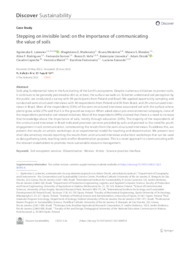Stepping on invisible land: on the importance of communicating the value of soils.
Stepping on invisible land: on the importance of communicating the value of soils.
Author(s): LATAWIEC, A. E.; MARKOWICZ, M. E.; MEDEIROS, B.; MENDES, M. S.; RODRIGUES, A. F.; GOMES, F.; VALLE, B. D.; LISOWSKA, K.; DROSIK, A.; CAPECHE, C. L.; MAIOLI, V.; FEDOROWICZ, K.; AZEVEDO, L.
Summary: Soils play fundamental roles in the functioning of the Earth's ecosystems. Despite numerous initiatives to protect soils, it continues to be generally perceived as dirt or, at best, the surface we walk on. To better understand soil perception by the public, we conducted a survey with 99 participants from Poland and Brazil. We applied opportunity sampling and conducted semi-structured interviews with 40 respondents from Poland and 30 from Brazil, and 29 unstructured interviews in Brazil. Most of the respondents (53%) of the semi-structured interviews associated soil with the surface where plants grow, while 27% said that it is the ground we step on. When asked about pro-environmental campaigns, none of the respondents pointed to soil-related initiatives. Most of the respondents (99%) claimed that there is a need to increase their knowledge about the importance of soils, mostly through education (30%). The majority of the respondents of the unstructured interviews in Brazil indicated provision services provided by soils and pointed to the need for youth engagement in soil communication, corroborating the results from the semi-structured interviews. To address this, we present the results on artistic workshops as an experimental model for teaching and dissemination. We present two short documentary movies reporting the results from unstructured interviews and artistic workshops that can be used as data gathering tools, teaching tools and for dissemination purposes. This is a novel approach to communicating with the relevant stakeholders to promote more sustainable resource management.
Publication year: 2022
Types of publication: Journal article
Unit: Embrapa Soils
Observation
Some of Embrapa's publications are published as ePub files. To read them, use or download one of the following free software options to your computer or mobile device. Android: Google Play Books; IOS: iBooks; Windows and Linux: Calibre.
Access other publications
Access the Agricultural Research Database (BDPA) to consult Embrapa's full library collection and records.
Visit Embrapa Bookstore to purchase books and other publications sold by Embrapa.

